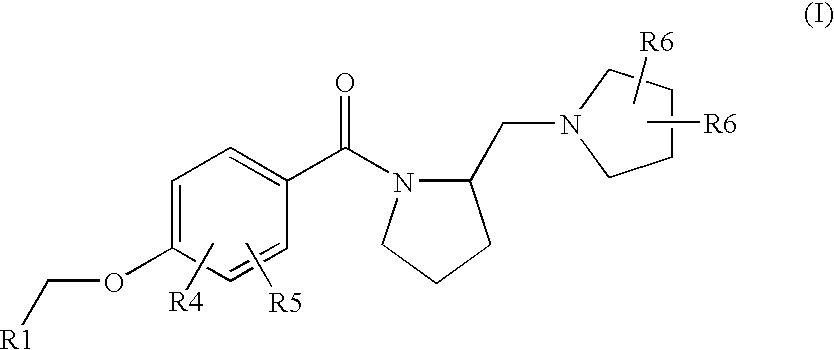Histamine H3 receptor inhibitors, preparation and therapeutic uses
a technology of histamine h3 receptor and inhibitor, which is applied in the field of new drugs, can solve the problems of poor blood-brain barrier penetration of imidazole-containing compounds, hepatic and ocular toxicities, and unsatisfactory side effects, and achieves selective and high affinity binding.
- Summary
- Abstract
- Description
- Claims
- Application Information
AI Technical Summary
Benefits of technology
Problems solved by technology
Method used
Image
Examples
example 1
5-[4-(2-(S)-Pyrrolidin-1-ylmethyl-pyrrolidine-1-carbonyl)-phenoxymethyl]-thiophene-2-carbonitrile
[0181]
Procedure B:
[0182]A mixture of (4-hydroxy-phenyl)-(2-(S)-pyrrolidin-1-ylmethyl-pyrrolidin-1-yl)-methanone (145 mg, 0.53 mmol), Cs2CO3 (0.34 g, 1.06 mmol), and 5-bromomethyl-thiophene-2-carbonitrile [CAS 134135-41-4] (0.13 g, 0.64 mmol) in DMF (5 mL) is stirred at room temperature overnight. The mixture is partitioned between EtOAc and H2O. The aqueous phase is extracted with EtOAc (2×). The combined organic phase is dried (Na2SO4) and concentrated. The crude product is purified by flash chromatography (40 g SiO2, elute 20% (10% 2M NH3 in MeOH / CH2Cl2) / 80% CH2Cl2 to 70% (10% 2M NH3 in MeOH / CH2Cl2) / 30% CH2Cl2). MS (ES+) m / e 396.3
example 2
(2-(S)-Pyrrolidin-1-ylmethyl-pyrrolidin-1-yl)-[4-(thiazol-4-ylmethoxy)-phenyl]-methanone
[0183]
Procedure C:
[0184]A mixture of (4-Hydroxy-phenyl)-(2-(S)-pyrrolidin-1-ylmethyl-pyrrolidin-1-yl)-methanone (190 mg, 0.69 mmol), Cs2CO3 (0.45 g, 1.4 mmol), potassium iodide (166 mg, 1 mmol) and 4-(chloromethyl)thiazole hydrochloride [CAS 7709-58-2] (0.17 g, 1.0 mmol) in DMF (5 mL) is stirred at room temperature overnight. The mixture is partitioned between EtOAc and H2O. The aqueous phase is extracted with EtOAc (2×). The combined organic phase is dried (Na2SO4) and concentrated. The crude product is purified by flash chromatography (40 g SiO2, elute 20% (10% 2M NH3 in MeOH / CH2Cl2) / 80% CH2Cl2 to 70% (10% 2M NH3 in MeOH / CH2Cl2) / 30% CH2Cl2). MS (ES+) m / e 372.3
Intermediate Preparation 5
2-Fluoro-4-(thiazol-4-ylmethoxy)-benzoic acid methyl ester
[0185]
Procedure D:
[0186]A mixture of 2-fluoro-4-hydroxy-benzoic acid methyl ester [CAS 197507-22-5] (1.0 g, 5.9 mmol), 4-(chloromethyl)thiazole hydrochlori...
example 3
[2-Fluoro-4-(thiazol-4-ylmethoxy)-phenyl]-(2-(S)-pyrrolidin-1-ylmethyl-pyrrolidin-1-yl)-methanone
[0187]
Procedure E:
[0188]To a mixture of 2-fluoro-4-(thiazol-4-ylmethoxy)-benzoic acid methyl ester (0.49 g, 1.8 mmol) in dioxane (20 mL) is added a solution of lithium hydroxide monohydrate (91 mg, 2.2 mmol) in water (5 mL). The mixture is stirred at room temperature overnight. The solvent is removed in vacuo and the crude lithium salt is used without purification.
[0189]To a mixture of 2-fluoro-4-(thiazol-4-ylmethoxy)-benzoic acid lithium salt (1.8 mmol) in CH2Cl2 (10 mL) and DMF (10 mL) is added EDC (0.41 g, 2.2 mmol), HOBt (0.29 g, 2.2 mmol), and DIEA (0.66 ml, 3.6 mmol). After a few minutes, (S)(+)-1-(2-pyrrolidinylmethyl)pyrrolidine (0.35 mL, 2.2 mmol) is added, and the mixture is stirred at room temperature overnight. The mixture is partitioned between water and ethyl acetate, and the aqueous phase is extracted with ethyl acetate (2×). The combined organic phase is dried (Na2SO4) an...
PUM
| Property | Measurement | Unit |
|---|---|---|
| temperature | aaaaa | aaaaa |
| temperature | aaaaa | aaaaa |
| temperature | aaaaa | aaaaa |
Abstract
Description
Claims
Application Information
 Login to View More
Login to View More - R&D
- Intellectual Property
- Life Sciences
- Materials
- Tech Scout
- Unparalleled Data Quality
- Higher Quality Content
- 60% Fewer Hallucinations
Browse by: Latest US Patents, China's latest patents, Technical Efficacy Thesaurus, Application Domain, Technology Topic, Popular Technical Reports.
© 2025 PatSnap. All rights reserved.Legal|Privacy policy|Modern Slavery Act Transparency Statement|Sitemap|About US| Contact US: help@patsnap.com



